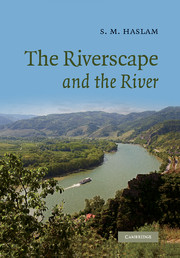Book contents
- Frontmatter
- Contents
- List of tables
- Preface
- Acknowledgements
- 1 Introduction
- 2 The natural river and its destruction
- 3 The natural riverscape and its modification
- 4 Resources I. Water resources and their loss
- 5 Development and variation of rivers
- 6 Development and variation of riverscapes
- 7 Building blocks of river vegetation
- 8 Building blocks of flood plain vegetation
- 9 Resources II. Plants and animals, cleaning and minerals
- 10 Building blocks of the riverscape
- 11 Patterns, boundaries and fragmentation
- 12 Resources III. Settlements and constructions
- 13 The harsh riverscape
- 14 The tempered or smiling riverscape
- 15 Envoi
- Bibliography
- Index to plant and animal vernacular and taxonomic names
- General subject index
12 - Resources III. Settlements and constructions
Published online by Cambridge University Press: 10 August 2009
- Frontmatter
- Contents
- List of tables
- Preface
- Acknowledgements
- 1 Introduction
- 2 The natural river and its destruction
- 3 The natural riverscape and its modification
- 4 Resources I. Water resources and their loss
- 5 Development and variation of rivers
- 6 Development and variation of riverscapes
- 7 Building blocks of river vegetation
- 8 Building blocks of flood plain vegetation
- 9 Resources II. Plants and animals, cleaning and minerals
- 10 Building blocks of the riverscape
- 11 Patterns, boundaries and fragmentation
- 12 Resources III. Settlements and constructions
- 13 The harsh riverscape
- 14 The tempered or smiling riverscape
- 15 Envoi
- Bibliography
- Index to plant and animal vernacular and taxonomic names
- General subject index
Summary
The power of man has grown in every sphere except over himself
(W. S. Churchill)Changes in multifunctional landscapes change multiple functions
(Bakheshuen et al., in Mander et al., 2001)Settlements
Ever since people existed, they have used rivers and used them increasingly as technology and populations increased, and the diversity of this use has been extraordinary. Recently, though, uses, particularly direct use, have declined, except for waste disposal and abstraction (Table 12.1). People have always settled by rivers (pre-mains supply, rivers or springs were essential). Rivers are the key to European development. The Danube and the Rhine opened the door to settlement from east to west, with settlements on river routes. Roman civilisation was aided by the Rhône. Towns were a legacy of Rome. The Romans used, bridged and altered rivers (and aqueducts), but their towns were sited more for military or state reasons. The river town dates from before or after Rome but may, like Colchester, London and York, have been used by Romans.
River settlements may start as an isolated homestead, and grow to a village, then a river town, but the progression is not necessary. A farm needs farm water: which may but need not be from a source large enough for a village. A river town, by definition, used river transport, so needed a river large enough for boats to bring riches. Some patterns of where there may be farms, river villages and river towns are shown in Figs. 12.1 and 12.2.
- Type
- Chapter
- Information
- The Riverscape and the River , pp. 281 - 306Publisher: Cambridge University PressPrint publication year: 2008



